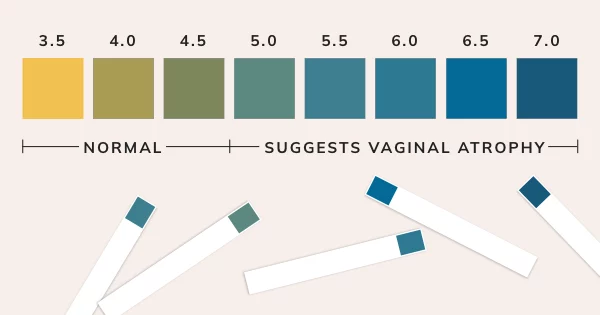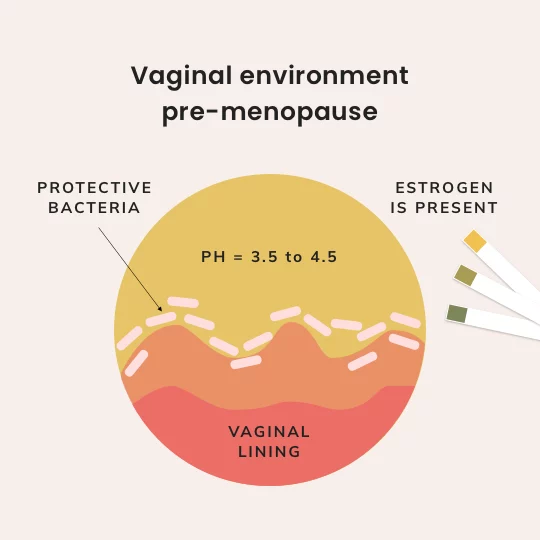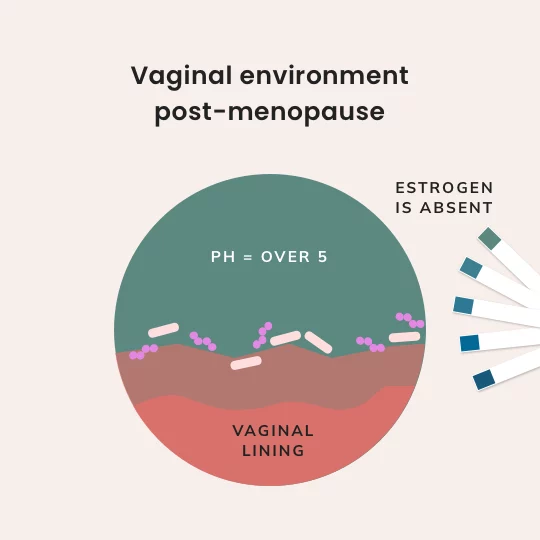Skip to a section:
Introduction
When you’re feeling dryness, pain, or burning down there, you may worry you have a UTI or yeast infection. But if you’re approaching menopause or well beyond it - it could be vaginal atrophy. Vaginal atophy is a medical term for what's also known as the genitourinary syndrome of menopause (GSM).
From vaginal dryness to UTIs, it’s essential to gain a comprehensive understanding of vaginal atrophy symptoms so that you can take steps to protect your health and well-being as you grow older.
Let's dive into what vaginal atrophy is, examining the cause of vaginal atrophy, its physical manifestations and how it feels, and then conclude with practical steps you can take if you think you have vaginal atrophy.
What causes vaginal atrophy?
The cause of vaginal atrophy is low estrogen levels - usually from menopause. Vaginal atrophy progresses over time as you transition through menopause and beyond.
Notably, unlike menopausal hot flashes that eventually go away, vaginal atrophy will not get better on its own. It can get worse. So, whether you are in your early 40s or your 90s, you may have vaginal atrophy.

What does vaginal atrophy look like?
If you’re Googling “vaginal atrophy symptoms” to see an image of what it looks like, it can be difficult to find an image that’s relatable because everyone’s vulva is unique.
One way to see if you have vaginal atrophy is to take a pH test. A pH of 5.0 or higher could suggest a lack of estrogen and therefore, vaginal atrophy.1

Vaginal atrophy can affect the vagina and the entire vulva, including the clitoris, labia, and urethra. As a result, you can experience a wide range of symptoms from vaginal dryness to frequent UTIs to stress incontinence.
Externally, vaginal atrophy can look like:
- Changes in the shape of your vulva
- Loss of plumpness and volume
- Clitoris becoming less prominent
- Skin that appears dry or irritated
- Tearing or bleeding of delicate tissues
- Labia discoloration or darkening
Are there pictures of vaginal atrophy?
If you’re trying to understand what vaginal atrophy looks like and you're Googling "vaginal atrophy pictures", the photos you'll see are confusing because vaginal atrophy manifests differently for everyone.
Instead, it can be useful to think of a metaphor. When your vagina has estrogen, the vaginal walls are thick, soft, flexible, and scrunchy like a sock. When estrogen declines, the vaginal walls become thin, shiny, tight, prone to tearing, and delicate like pantyhose.

What does vaginal atrophy feel like?
One of the earliest symptoms of vaginal atrophy that you can feel is vaginal dryness2. Internally, the vagina may feel dry and lacking in lubrication, leading to discomfort and pain. Externally, you may feel that your vulva is dry or itchy.
But vaginal dryness is just the tip of the iceberg. Many more symptoms can follow. Common symptoms of vaginal atrophy that you can feel:
- Itching
- Burning
- Pain with sex
- Loss of nerve sensitivity
- Difficulty with orgasm
- Pain when peeing
- Increased urgency to pee
- Inflammation around the urethra
- Stress incontinence
- Frequent urinary tract infections
- Pressure in the vagina
- Feeling like the vagina is too tight
- Shortening of the vaginal canal
As a result of these physical changes, you may also notice an interference with libido, sleep, everyday activities, enjoyment of sex, ability to seek a new relationship, and mood and temperament3.

What should you do if you suspect vaginal atrophy?
If you're concerned about vaginal atrophy, you're not alone. Many women experience this condition during their lifetime. Vaginal atrophy does not get better on its own, so it's crucial to take proactive steps to address your symptoms and seek appropriate care.
Consider taking an at-home vaginal pH test to gain a better understanding of your vaginal health. Vaginal pH test strips are useful, effective, and affordable. You can buy them at your local pharmacy and use the results to start a conversation with a trusted medical provider.


If your symptoms are bothersome and interfering with your health or quality of life, talk to a trusted medical provider about your concerns and explain in detail what it is that you are experiencing.
Will vaginal estrogen help with my vaginal atrophy?
Hormone-based treatments are often recommended for menopause symptoms, including vaginal atrophy. There are two main types of menopausal hormone therapy:
- Systemic hormones (usually taken as a pill or patch)
- Local therapy (applied directly to the vagina as a cream or insert)
Systemic hormones treat symptoms like hot flashes, night sweats, and vaginal dryness. Local therapies like vaginal estrogen will not help with hot flashes, but have been proven to both help with vaginal dryness and prevent infections like UTIs.4
Many women do not want or cannot take hormone-based treatments due to concerns about safety, risk of side effects, and hormone exposure. While there is strong evidence to show that systemic hormones increase the risk of serious side effects, there is no such evidence for local therapy.
Topical vaginal estrogen is prescribed in very low doses that has been shown to have very low absorption into the bloodstream and could therefore be safer than systemic estrogen. Data from the Women’s Health Initiative Observational Study showed that for postmenopausal women who used vaginal estrogen, the risk of invasive breast cancer, colorectal cancer, endometrial cancer, stroke, and blood clots was the same as those that did not use vaginal estrogen.5
Next steps
When it comes to treating vaginal atrophy, you have options.
If you’re looking for temporary relief from dryness, vaginal lubricants and moisturizers can help with mild symptoms of vaginal atrophy. Remedies like coconut oil are available over the counter.
Choosing to try hormone-based treatment is a decision you can make, but you should work with a board-certified doctor to determine if it is appropriate for you.
At Interlude, our board-certified physicians are here to help. We do not offer systemic hormones, but we do offer local therapies such as vaginal estrogen in the form of an estradiol cream or estradiol suppository.



